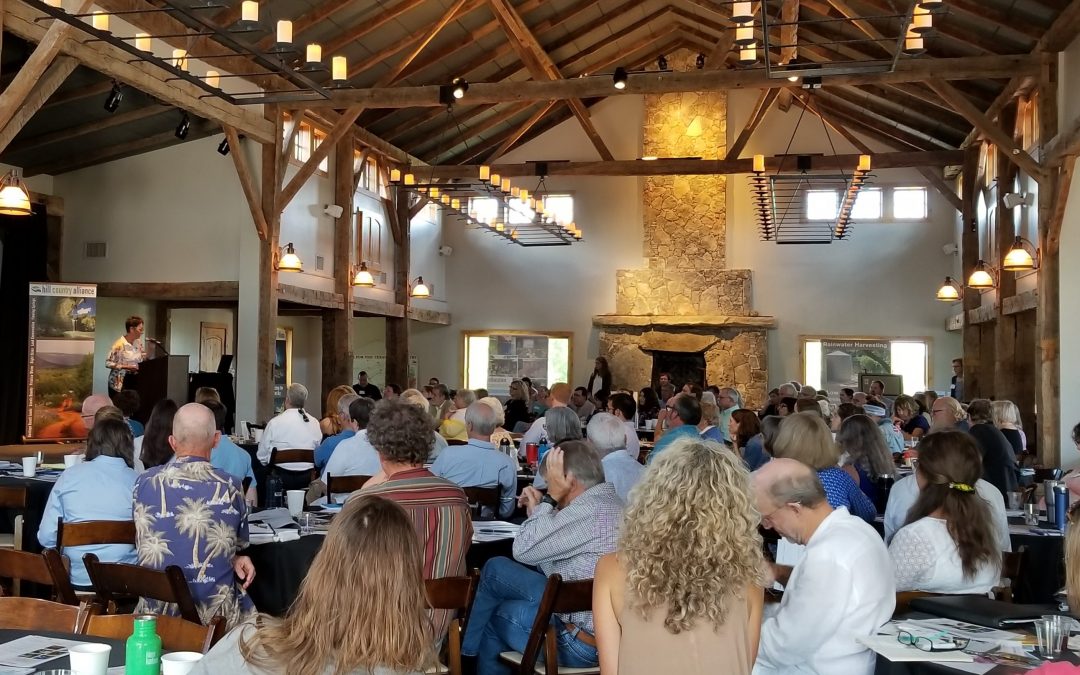 On September 21st, conservation leaders from across the Texas Hill Country met at Camp Lucy in Dripping Springs for the Hill Country Alliance’s Annual Leadership Summit. The event theme, From Local to Regional: The Shared Story of the Texas Hill Country, brought together more than 190 participants to learn about conservation strategies such as collaboration and story-telling to solve complex natural resource problems.
On September 21st, conservation leaders from across the Texas Hill Country met at Camp Lucy in Dripping Springs for the Hill Country Alliance’s Annual Leadership Summit. The event theme, From Local to Regional: The Shared Story of the Texas Hill Country, brought together more than 190 participants to learn about conservation strategies such as collaboration and story-telling to solve complex natural resource problems.
Jim Blackburn, president of the Trinity Edwards Springs Protection Association (TESPA), kicked off the summit by highlighting the legal and cultural challenges facing water conservation in the region. “If the springs don’t flow, our public property—the surface water—is taken from us.” Blackburn noted that Texas law does not acknowledge the connection between surface and groundwater; the law, he emphasized, needs to be changed. Such changes will require the Hill Country conservation community to be increasingly more creative.
Next, Francine Romero, professor at University of Texas-San Antonio and HCA board member, moderated a panel discussion focused on the linkage between land and water protection. Panelists—including Brigid Shea, Travis County Commissioner; Blair Fitzsimons, CEO of Texas Agricultural Land Trust; Susan Courage, with the City of San Antonio’s Edwards Aquifer Protection Program; and Todd Figg, Uvalde County landowner—discussed their challenges and success stories.
“We are faced with a crisis of land ownership,” noted Fitzsimons. Keeping families on the land to continue generations of stewardship helps protect land and water resources. As Figg, a landowner, attested properties are being sold and subdivided across the Hill Country. Successful models of land and water conservation can be found across our region, and pooling a greater variety of public and private funds can make conservation affordable for the people that work the land.
The keynote speaker of the day was Dr. Betty Sue Flowers, professor emeritus from the University of Texas at Austin and former director of the LBJ Presidential Library. Dr. Flowers’ presentation focused on the importance of storytelling in building shared understanding around complicated problems. As Flowers pointed out, the future is only a story—it can be changed and shaped in dramatic ways, and ultimately our understanding of the present is influenced by the story we are telling about the future.
Flowers urged attendees to bring non-traditional partners together to create a shared vision of the future. “It’s the space between science and passion where we are at our best,” commented Flowers, who then asked, “How do we tell stories together that incorporate diversity? How do we go forward together respecting everyone’s individual story while creating a wider, deeper, shared one together?” To do so, we must draw from one another’s stories and create shared power in the process.
The afternoon was capped by stories of successes from around Central and West Texas. Bill Wren, from the McDonald Observatory, underscored the importance of deep running stories about the night skies of Texas in educating everyone from tourists to oil refinery workers about light pollution. Wren noted, “We have a sense of pride to appeal to for protecting the night skies around the observatory.”
Shifting from the night skies to land stewardship, Cathy Downs from Monarch Watch shared a story of numerous partners—landowners, businesses, and government agencies at the local, state, and federal level—working together to save Monarch Butterflies. “The Hill Country is in a unique position, at the confluence of the migratory pathways, both north and south.” By adding milkweed and nectar plants to the Hill Country, we are creating an enhanced food web that supports over 4 million monarchs.
Garry Merritt, Real County Judge and Hill Country Alliance board president, discussed the process for creating a comprehensive plan for Real County. When beginning such an ambitious process, Merritt noted, “You can’t get there from here. You have to first develop respect and trust; only then can you begin to develop a shared vision and path for how to get there.”
Author Wes Ferguson brought it all home as he shared stories and images from his new book about the Blanco River. “Texas rivers are always changing,” Ferguson observed. This change goes far beyond the flow in the channel to include the inhabitants that live along and shape the health of our river basins. As Flowers noted, our challenge and opportunity is to create a shared story that is wider, deeper, and creates more power in our discussions of stewardship.
The day concluded with breakout conversations and shared inspirational success stories that illuminated opportunities for collaboration between groups and individuals. “The biggest takeaway is the immense opportunity represented by a room full of passionate individuals, like what we have seen today,” commented Katherine Romans, executive director of the Hill Country Alliance. “We can be successful by bringing diverse perspectives together to find a common vision for the Hill Country.”
To learn more about the Leadership Summit, visit the HCA webpage at www.hillcountryalliance.org and please stay engaged with news, events and developments by subscribing to the Hill Country Alliance newsletter.
The Hill Country Alliance is a non-profit organization dedicated to raising public awareness and building community support to preserve the natural resources and heritage of the Central Texas Hill Country.







